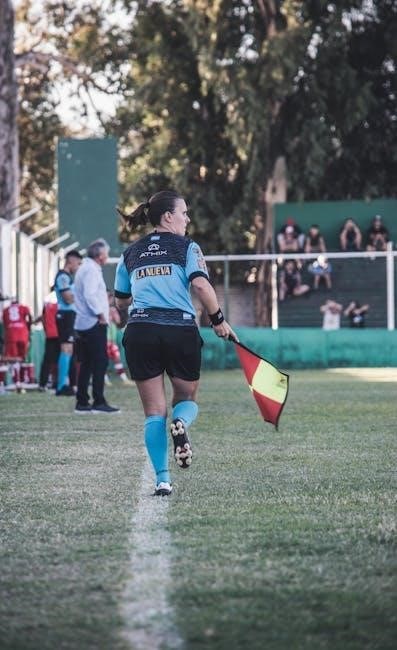This comprehensive guide offers expert strategies, formations, and drills for flag football success. Designed for coaches and players, it includes detailed plays and practice plans to elevate team performance.

Understanding Flag Football Formations
Mastering flag football formations is key to strategic success. Common setups include spread, trips, stack, double back, I, and single-back, each dictating player alignment and offensive/defensive strategies.
Spread Formation
The spread formation is a popular and versatile setup in flag football, designed to create space and confuse defenses. It typically features receivers spread out across the field, with the quarterback in the center. This formation allows for quick passes, misdirection plays, and the ability to exploit defensive weaknesses. Coaches often use motion adjustments to make the play more dynamic, keeping the defense guessing. The spread formation is ideal for teams with agile players who can capitalize on open lanes and quick decision-making. It’s a cornerstone of modern flag football strategy, offering flexibility and offensive creativity. Proper execution requires precise timing and communication among players, making it a key focus in practice drills and game planning.
Trips Formation
The trips formation is a dynamic alignment where three receivers line up on one side of the field, creating a trips bunch. This setup is designed to overload one area, forcing the defense to commit resources and potentially leaving other zones vulnerable. The quarterback can exploit this by throwing quick slants or screens to the trips side or handing off to the running back, who attacks the weaker defensive front. Motion adjustments are often used to enhance the trips formation, allowing receivers to shift and create mismatches. This formation is particularly effective in creating confusion among defenders and generating quick scoring opportunities. Coaches emphasize the importance of precise timing and execution to maximize the trips formation’s potential in game situations.
Stack Formation
The stack formation is a versatile alignment where receivers and players are positioned in a tight bunch, often creating mismatches and confusion for the defense. This setup typically features two receivers on one side and a tight stack on the other, allowing for quick screens, slants, and mismatches. The quarterback can exploit defensive weaknesses by reading the alignment and delivering the ball to the open receiver. The stack formation is particularly effective in creating traffic and forcing defenders to make quick decisions. Coaches often use motion adjustments to further enhance the stack’s effectiveness, creating opportunities for big plays. Proper execution and timing are critical to maximizing the stack formation’s potential in both youth and competitive flag football leagues.
Double Back Formation

The double back formation is a dynamic setup where two running backs align behind the quarterback, creating a strong rushing threat and forcing defensive adjustments. This formation often features one back deep and another closer to the line, allowing for handoffs, fakes, and play-action passes. The double back formation is ideal for controlling the tempo of the game and creating defensive confusion. Coaches can utilize motion to shift players, exploiting defensive weaknesses and opening up lanes for big gains. This formation is particularly effective in short-yardage situations and goal-line scenarios, where power running and misdirection plays can dominate. Proper execution and player coordination are key to maximizing the double back formation’s effectiveness in both offensive and trick play scenarios.
I Formation
The I formation is a classic alignment in flag football, featuring a quarterback, a fullback, and a running back lined up directly behind each other. This setup is ideal for power running plays and play-action passes, as it creates a strong rushing threat and can freeze defensive players. The fullback typically blocks for the running back, while the quarterback can fake handoffs to create confusion. The I formation is highly effective in short-yardage and goal-line situations, where physicality and misdirection are crucial. Coaches often use motion to shift receivers and create mismatches, making this formation versatile and difficult to defend. Proper execution of blocks and fakes is essential to maximize the I formation’s potential in both offensive and trick play scenarios.
Single-Back Formation
The Single-Back Formation is a versatile offensive setup featuring one running back behind the quarterback. This alignment emphasizes speed and agility, allowing for quick handoffs and sharp cuts. The quarterback often operates from a shotgun snap, enabling rapid decision-making. Receivers are typically spread out to create spacing and exploit defensive mismatches. This formation is ideal for teams with a dynamic running back who can excel in open spaces. Coaches often incorporate motion to shift receivers and create favorable matchups. The Single-Back Formation is effective for both inside and outside runs, as well as play-action passes that deceive defenders. Its simplicity makes it easy to execute while still offering the potential for explosive plays, making it a cornerstone of many successful flag football strategies.

Offensive Strategies for Success
Mastering offensive strategies is key to dominating flag football. Focus on quick reads, precise routes, and explosive plays. Utilize motion, misdirection, and timing to outsmart defenders and create scoring opportunities consistently.
Basic Offensive Plays
Basic offensive plays are the foundation of any successful flag football team. These plays are designed to be simple yet effective, allowing players to execute them confidently. Start with the Spread Formation, where receivers spread out to create space. A classic play is the Slant Route, where the receiver runs diagonally to create a quick passing option. Another essential play is the Hook Route, where the receiver runs a short distance before turning to face the quarterback, creating a reliable target. Additionally, the Quick Out is a versatile play that gets the ball to the receiver quickly, allowing them to make a play in the open field. These plays focus on quick decisions by the quarterback and precise execution by the receivers. As players gain experience, they can progress to more complex plays, but mastering these basics is crucial for building a strong offensive strategy.

Intermediate Offensive Plays
Intermediate offensive plays build on the basics while introducing more complexity and strategy. These plays are designed to exploit defensive weaknesses and create mismatches. A popular intermediate play is the Flood Concept, where multiple receivers flood one side of the field, overwhelming the defense. Another effective play is the Shallow Cross, where receivers cross paths horizontally, creating confusion and separation. Additionally, the Wheel Route combines a deep pass with a sweeping motion, providing a high-reward option. These plays require better timing, communication, and coordination between the quarterback and receivers; They also introduce the concept of reading defenses and adjusting routes accordingly. Mastering these plays enhances the team’s ability to adapt and execute under pressure, making them a cornerstone of a competitive offense.
Advanced Offensive Plays
Advanced offensive plays are designed for experienced teams looking to maximize scoring opportunities. These plays often involve complex route combinations and high-reward strategies. The Mesh Concept is a favorite, where receivers crisscross to create separation and confusion. Another advanced play is the Dagger Concept, which combines deep routes with intermediate crosses to attack both levels of the defense. Additionally, the Play-Action Pass is a powerful tool, using a fake handoff to freeze defenders before delivering a deep strike. These plays require precise timing, advanced route-running skills, and a high level of communication between the quarterback and receivers. When executed correctly, they can be nearly unstoppable, making them a key part of any championship-caliber offense.

Trick Plays to Outsmart Opponents
Trick plays are a game-changer in flag football, designed to catch opponents off guard and create scoring opportunities. The Double Pass is a classic, where the quarterback hands off to a receiver, who then pulls up and throws to another target. Another effective trick is the Reverse Pass, where a wide receiver reverses direction and throws to a streaking quarterback. The Hook and Lateral is also a fan favorite, where a receiver catches a short pass and laterals to a teammate for a big gain. These plays exploit defensive weaknesses and create confusion. To master trick plays, timing and teamwork are crucial. Practice them extensively to ensure flawless execution, as they can lead to explosive touchdowns and momentum swings. Use them sparingly to keep opponents guessing and maintain a competitive edge.

Defensive Tactics to Shut Down Opponents
Mastering defensive tactics is crucial for victory. Employ base schemes to disrupt opponents and utilize blitz packages to pressure the quarterback. Adapt strategies to dominate games.
Base Defensive Schemes
A solid defense begins with a well-executed base scheme. These formations are designed to counter common offensive alignments, ensuring your team is prepared for any play. The 3-2 and 2-3 setups are popular, balancing pass and run defense. Players must align correctly, with linebackers reading the offense and defensive backs providing coverage. Communication is key to shutting down opponents. These schemes are adaptable, allowing for adjustments based on the game flow. Mastering base defensive schemes builds a strong foundation, enabling your team to anticipate and react effectively; Proper execution can disrupt offensive rhythm and create turnovers, giving your team a strategic edge. Focus on alignment, assignment discipline, and quick reactions to dominate defensively.
Effective Blitz Packages
Blitz packages are aggressive defensive strategies designed to pressure the quarterback and disrupt offensive rhythm. These schemes involve sending extra defenders to rush the passer, creating confusion and limiting the quarterback’s time to react. Effective blitzes can force quick throws, sacks, or turnovers. Common blitz types include man and zone blitzes, each tailored to exploit specific weaknesses. Timing and execution are critical, as blitzing leaves the defense vulnerable if the quarterback identifies the scheme. Coaches must balance aggression with coverage to avoid large plays. When executed properly, blitz packages can transform your defense into a formidable unit, keeping opponents on their heels and creating game-changing moments. Adaptability and smart player execution are key to maximizing their impact in critical game situations.

Special Plays for Critical Situations
Master critical moments with strategic plays designed for high-pressure scenarios. These situational strategies ensure optimal execution in limited-time or goal-line situations, maximizing scoring opportunities and securing victories.
Two-Minute Drill Strategies
A well-executed two-minute drill is crucial for securing last-minute scores. This section outlines strategies to maximize efficiency, including play selection, timing, and player assignments. Emphasize quick passes and aggressive routes to gain yards rapidly. Utilize spread formations to create mismatches and isolate speedy receivers. Teach quarterbacks to make swift decisions and avoid sacks. Incorporate motion to confuse defenses and create openings. Practice situational awareness, such as spiking the ball to stop the clock. Ensure receivers know sideline routes to preserve time. Defensive backfield must stay disciplined to prevent big plays. Coaches should drill these scenarios repeatedly to build confidence and precision under pressure. A polished two-minute drill can turn close games into victories.
Goal-Line Situations
Goal-line situations demand precision and execution. This section details strategies for scoring or defending within 10 yards of the end zone. Emphasize quick slants, fade routes, and play-action passes to exploit defensive weaknesses. Utilize stack formations to create confusion and isolate receivers. Incorporate trick plays like reverses or shovel passes to catch defenses off guard. Teach quarterbacks to deliver the ball quickly and accurately to avoid sacks. Defensively, focus on tight man-to-man coverage and zone drops to protect the end zone. Stress the importance of jumping routes and pressuring the quarterback. Practice goal-line scenarios extensively to build confidence and instincts. These high-stakes moments often decide games, making mastery of these strategies essential for success. Drills should simulate game-like pressure to prepare players for clutch performances.
Practice Plans for Skill Development
Enhance your team’s skills with structured drills focusing on offensive and defensive techniques. These plans cover agility, passing accuracy, and defensive reads to build a well-rounded team.
Offensive Drills
Master the fundamentals of flag football with these dynamic offensive drills. Start with ball-handling exercises to improve quarterback and running back precision. Incorporate route-running drills, focusing on sharp cuts and timing. Use formation-specific practices to perfect alignment and motion techniques. Include passing accuracy drills, emphasizing Reads and decision-making. Add flag-pulling evasion exercises to enhance elusiveness. Implement red-zone drills to simulate goal-line situations. Practice two-minute drills for late-game scenarios. Rotate players through positions to ensure versatility. Conclude with scrimmages to apply skills in game-like conditions. These drills build a well-rounded, adaptable offense ready to dominate any opponent.
Defensive Drills
Sharpen your defense with these targeted drills. Begin with flag-pulling exercises to improve reaction time and accuracy. Use footwork and agility drills to enhance defensive positioning and lateral movement. Incorporate reaction drills, where defenders respond to offensive movements. Practice pass-coverage techniques, focusing on reading the quarterback and intercepting passes. Implement blitz packages to simulate pressure on the offense. Conduct tackling drills (flag-specific) to emphasize proper form and safety. Use scrimmage-like situations to apply defensive strategies in game conditions. Rotate players through defensive positions to build versatility. End with a review of defensive alignments and adjustments. These drills ensure a strong, adaptable defense capable of countering any offensive strategy.

Additional Tools for Coaching Success
This section provides essential tools for coaches, including a detailed playbook legend, player acronyms, and printable wristband sheets. It also offers a coupon code for FirstDown PlayBook membership, enabling play customization and enhancing overall coaching efficiency.
Playbook Legend and Player Acronyms
The playbook legend is a crucial reference guide that explains the symbols, abbreviations, and terminology used throughout the playbook. It ensures clarity for coaches and players, making it easier to understand complex plays. Common player acronyms include QB (quarterback), RB (running back), WR (wide receiver), and TE (tight end). Additionally, the legend details formations, routes, and defensive assignments, providing a universal language for the team. This section also includes color-coded diagrams to visually represent player movements and responsibilities. By standardizing these elements, the legend helps players and coaches execute plays seamlessly, fostering better communication and teamwork. It’s an essential tool for maximizing the effectiveness of the strategies outlined in the playbook. Proper understanding of the legend is key to unlocking the playbook’s full potential. Coaches can use this section to ensure everyone is on the same page, from youth teams to advanced players.
